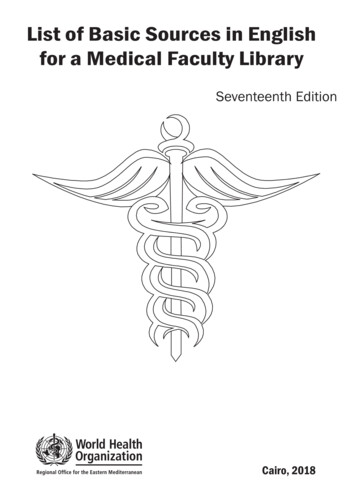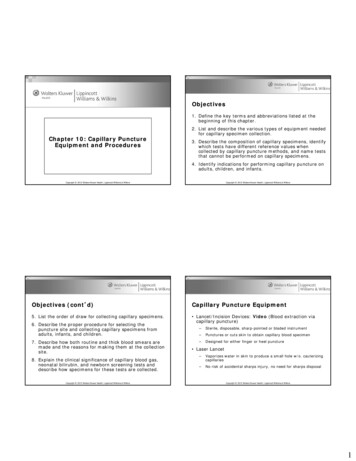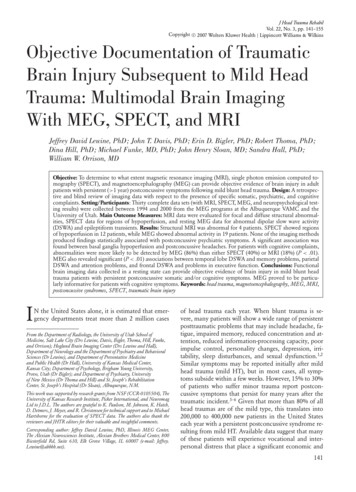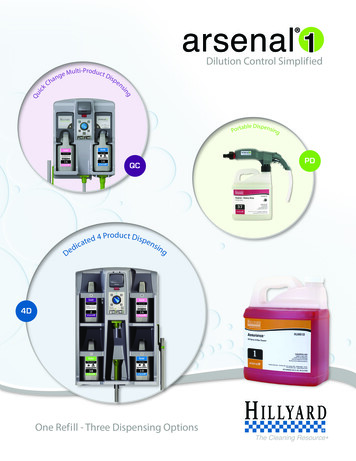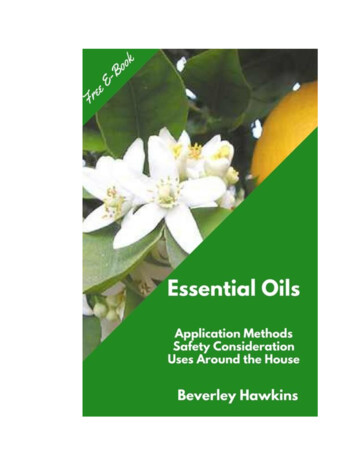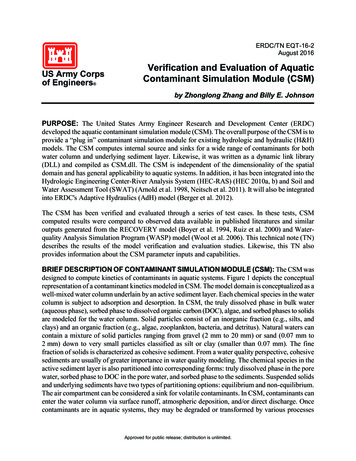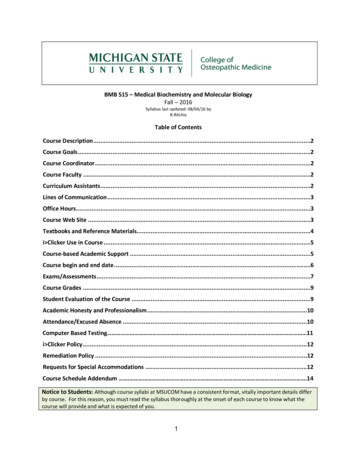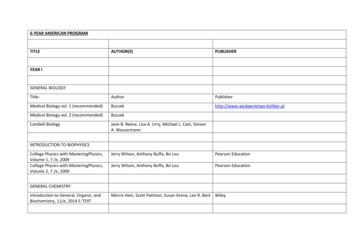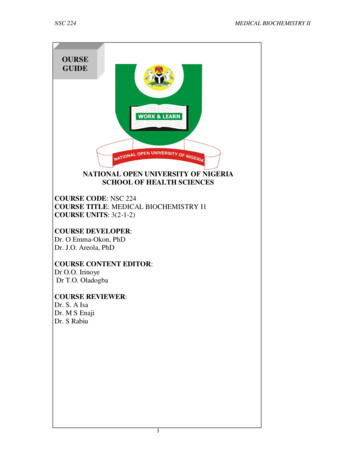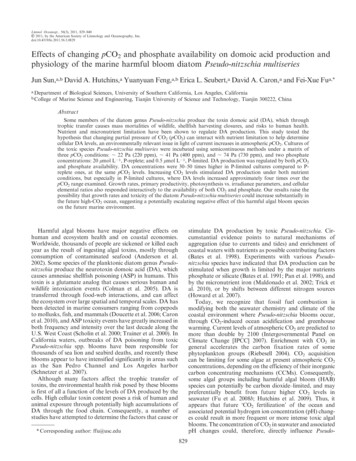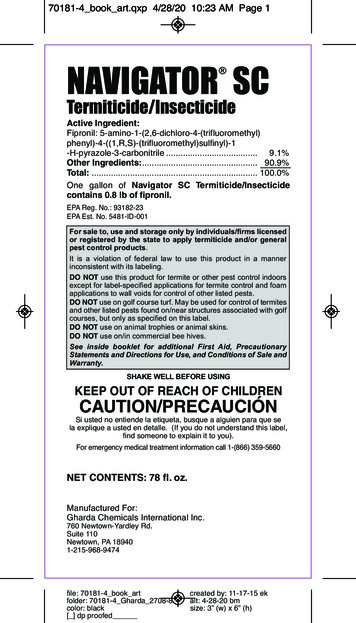
Transcription
10045-10 Ch10-rev.qxd11/20/062:45 PMPage 207Chapter 10%C789.—.456XDilution andConcentrationOBJECTIVESUpon completion of this chapter, the technician student willbe able to: Describe the relationship of active ingredients anddiluents if the amount of active ingredient remainsconstant and the amount of diluent is increased ordecreased.TERMS Alligation Alligationalternate Alligationmedial Diluent Stock solution Determine the percent strength and ratio strength ofa given product when the active ingredient remainsconstant and the amount of diluent is increased ordecreased. Determine the volume of solution of a desired strengthgiven a specified quantity of any given strength. Determine the volume of a specified stock solutionneeded to prepare a given solution. Determine the quantity of an active ingredient in aspecified amount of solution needed to prepare agiven solution. Define the alligation methods of problem solving. Use the alligation methods (alligation alternate andalligation medial) to determine the percent strengthof alcohol mixtures. Use the alligation methods (alligation alternate andalligation medial) to determine relative amounts ofcomponents mixed together to make a mixture of arequired strength.207
10045-10 Ch10-rev.qxd20811/20/062:45 PMPage 208Pharmaceutical Calculations for the Pharmacy Techniciandiluent A substance addedto a pharmaceutical productto reduce its strength, ordilute it. A diluent most oftenhas no drug substance in it;examples are sterile waterand petrolatum.Chapter 9 addresses problems arising from the quantitative relationship betweenspecific ingredients and the pharmaceutical preparation as a whole. This chapterintroduces problems of a slightly different character: those that arise when pharmaceutical preparations are diluted (by the addition of diluent or by admixture withsolutions or mixtures of lower strength) or are concentrated (by the addition ofactive ingredient or by admixture with solutions or mixtures of greater strength).Pharmaceutical preparationbefore dilutionPharmaceutical preparationafter dilution (same amountof active drug although thevolume has doubled)Problems such as these sometimes seem complicated and difficult. Solving someof these calculations requires a series of steps. Understanding the basic concepts ofdilution and concentration uncomplicates these problems.Many problems can be solved in several ways. The best way is not necessarilythe shortest: the best way is the one that is clearly understood and that leads to thecorrect answer.Rules to Simplify the Calculation%C789.—.456X123–0 These two rules, wherever they may be applied, greatly simplify the calculation:1. When ratio strengths are given, convert them to percentage strengths before settingup a proportion. It is much easier to solve using a decimal or percent, like10 (%) : 0.2 (%) than a fraction represented by the ratio like 1 10 : 1 500.2. Whenever proportional parts enter into a calculation, reduce them to lowest terms.Instead of calculating with a ratio like 25 (parts) : 75 (parts), simplify it to1 (part) : 3 (parts).Relationship Between Strengthand Total QuantityIf a mixture of a given percentage or ratio strength is diluted to twice its originalquantity, its active ingredient will be contained in twice as many parts of the whole,and its strength therefore will be reduced by one-half. So if 50 mL of a solution containing 10 g of active ingredient with a strength of 20% or 1 : 5 w/v is diluted to 100 mL,
10045-10 Ch10-rev.qxd11/20/062:45 PMPage 209CHAPTER 10 Dilution and Concentrationthe original volume is doubled, but the original strength is now reduced by one-halfto 10% or 1:10 w/v.If, then, the amount of active ingredient remains constant, any change in thequantity of a solution or mixture of solids is inversely proportional to the percentage or ratio strength; that is, the percentage or ratio strength decreases as the quantity increases, and vice versa. In other words, if the amount of active ingredientremains the same and the volume gets larger, the concentration gets smaller. Likewise, if the amount of active ingredient remains the same and the volume getssmaller, the concentration increases.This relationship is generally true except for volume-in-volume and weight-involume solutions containing components that contract when mixed together. It is notpossible to add the volume of ingredients and get the total volume of the final product in all cases. It is possible when mixing solids.Problems in this chapter generally may be solved by one of the following methods:1. Inverse proportion:C1 Q2 C2 Q1where C concentration and Q quantity.2. The following formula:(quantity 1) (concentration 1) (quantity 2) (concentration 2)That is,Q1 C1 Q 2 C23. Determining the quantity of active constituent (solute) needed and then calculating the quantity of the available solution (usually concentrated or stock solution) that will provide the needed amount of constituent.For most situations the student technician is encouraged to use the formulamethod of solving these dilution and concentration problems. Sometimes the thirdmethod is the easiest of the three, usually when the strength of the product is verysmall and the technician is using a prepared strength available in a vial or ampul.Examples of these are detailed later in the chapter. In the formula method the second quantity and second concentration are always that of the final product, not of theactive ingredient or diluent.Dilution and Concentration of LiquidsDetermination of Percentage or Ratio StrengthCalculating the percentage or ratio strength of a solution made by diluting or concentrating (by evaporation) a solution of given quantity and strength entails thefollowing.209
10045-10 Ch10-rev.qxd21011/20/062:45 PMPage 210Pharmaceutical Calculations for the Pharmacy TechnicianExamples:If 500 mL of a 15% v/v solution of methyl salicylate in alcohol is diluted to 1500 mL,what is the percentage strength v/v?Water1500 mLAdded volume (from water)15%500 mL500 mLOriginal 15% concentrationQ1 C1 Q2 C2500 ( mL ) 15 (%) 1500 ( mL ) X (%)X 5%, answerSolve by Inverse Proportion:1500 mL 15% 500 mL X %X 5%, answerCalculate the Active Ingredient:500 mL of 15% v/v solution contains 75 mL of methyl salicylate (active ingredient).1500 mL 100% X%75 mLX 5%, answerIf 50 mL of a 1:20 w/v solution of aluminum acetate is diluted to 1000 mL, what isthe ratio strength w/v?1 : 20 5%Q1 C1 Q2 C250 ( mL ) 5 (%) 1000 ( mL ) (%)X 0.25% 1 : 400, annswer
10045-10 Ch10-rev.qxd11/20/062:45 PMPage 211CHAPTER 10 Dilution and ConcentrationSolve by Inverse Proportion:1 201000 mL 5% 1000 mL 50 mL50 mL XX%X 1 400 1: 400, answerX 0.25% 1: 400, answerCalculate the Active Ingredient:50 mL of a 1:20 solution contains 2.5 g of aluminum acetate.2.5 g 1000 mL 1gX mLX 400 mLRatio strength 1 : 400, answer?%C789.—.456X123–0 Strong coffeeCritical Thinking 10.1Dilution of a solid or liquid does not entail adding moredrug. Therefore, the amount of drug in the diluted productis the same; only the volume is larger.If a cup of coffee is too strong for a person’s taste, theperson may add water to dilute it. No additional coffee is used.Diluting strong coffeeBecause no additional coffee was added,the drink is now less concentrated.Determining Amount of Solution of a Desired StrengthCalculating the amount of solution of a desired strength that can be made by dilutingor concentrating (by evaporation) a specified quantity of a solution of given strengthinvolves the following.211
10045-10 Ch10-rev.qxd21211/20/062:45 PMPage 212Pharmaceutical Calculations for the Pharmacy TechnicianExamples:How much 10% w/w (in grams) ammonia solution can be made from 1800 g of28% w/w strong ammonia solution?Q1 C1 Q2 C21800 ( g ) 28 (%) X ( g ) 10%X 5040 g, answerSolve by Inverse Proportion:10% 1800 g 28%XgX 5040 g, answerCalculate the Active Ingredient:1800 g of 28% ammonia water contains 504 g of ammonia (100%).10% 504 g 100%XgX 5040 g, answerHow much (in milliliters) of a 1 : 5000 w/v solution of phenylmercuric acetate canbe made from 125 mL of a 0.2% solution?1 : 5000 0.02%Q1 C1 Q2 C2125 ( mL ) 0.2 (%) X ( mL ) 0.02 (%)X 1250 mL , annswerSolve by Inverse Proportion:0.02% 125 mL 0.2%X mLX 1250 mL, answerOr0.2% 1 : 5001 5000 125 mL 1 500X mLX 1250 mL, ansswer
10045-10 Ch10-rev.qxd11/20/062:45 PMPage 213CHAPTER 10 Dilution and Concentration213Calculate the Active Ingredient:125 mL of a 0.2% solution contains 0.25 g of phenylmercuric acetate1g5000 mL 0.25 gX mLX 1250 mL, answerStock SolutionsStock solutions are solutions of known concentration that are prepared by the pharmacist or technician for convenience in dispensing. They are usually strong solutionsfrom which weaker ones may be made conveniently. When correctly prepared, thesesolutions enable the pharmacist to obtain small quantities of medicinal substancesthat are to be dispensed in solution.Stock solutions usually are prepared on a weight-in-volume basis, and their concentration is expressed as a ratio strength or less frequently as a percentage strength.Amount of Solution Needed to Prepare Desired SolutionCalculating the amount of a solution of given strength that must be used to preparea solution of desired amount and strength involves the following.Examples:How much (in milliliters) of a 1:400 w/v stock solution should be used to make 4 Lof a 1 : 2000 w/v solution?4 L 4000 mL1 : 400 0.25% 1 : 2000 0.05%Q1 C1 Q2 C2X ( mL ) 0.25% 4000 mL 0.05 (%)X 800 mL, answerSolve by Inverse Proportion:0.25% 4000 mL X mL0.05%X 800 mL, answerOr1 400 4000 mL 1 2000X mLX 800 mL, answerstock solution A solutionof a known concentration prepared for the convenience ofdispensing; usually a strongsolution from which weakerones can be made conveniently.
10045-10 Ch10-rev.qxd21411/20/062:45 PMPage 214Pharmaceutical Calculations for the Pharmacy TechnicianCalculate the Active Ingredient:4000 mL of a 1 : 2000 w/v solution requires 2 g of active constituent (solute), thus:1 g 400 mL 2 g X mLX 800 mL, answerHow much (in milliliters) of a 1 : 400 w/v stock solution should be used in preparing 1 gal of a 1:2000 w/v solution?1 gal 3785 mL1: 400 0.25% 1 : 2000 0.05%Q1 C1 Q2 C2X 0.25% 3785 ( mL ) 0.05 (%)X 757 mL, answerSolve by Inverse Proportion:0.25% 3785 mL X mL0.05%X 757 mL, answerCalculate the Active Ingredient:To make 1 gal of a 1:2000 w/v solution requires 1.89 g of active constituent, thus:1.89 g X mL 1g400 mLX 756 mL, answerHow much (in milliliters) of a 1% stock solution of a certified red dye should be usedin preparing 4000 mL of a mouthwash that is to contain 1 : 20,000 w/v of the certifiedred dye as a coloring agent?1 : 20, 000 0.005%Q1 C1 Q2 C2X 1 (%) 4000 ( mL ) 0.005 (%)X 20 mL, answerSolve by Inverse Proportion:1%4000 mL X mL0.005%X 20 mL, answer
10045-10 Ch10-rev.qxd11/20/062:45 PMPage 215CHAPTER 10 Dilution and ConcentrationCheck:1% stock solutioncontains20 mL 0.01 1 : 20,000 solutioncoontains 4000 ( mL ) 0.000050.2 gcertified red dyeCalculate the Active Ingredient:To make 4000 mL of a 1:20,000 w/v solution requires 0.2 g of certified red dye, thus:1 g 100 mL 0.2 g X mLX 20 mL, answerHow much (in milliliters) of a 1 : 50 stock solution of ephedrine sulfate should beused in compounding the following prescription?Dr. Debra Lawson888 NW 27th Ave., Miami, FL 98885247-555-6613Name: Virginia MillhouseRx:Sig:678 Apple St.Ephedrine sulfate 0.25%Rose water ad 30 mLFor the nose.Dr. Debra LawsonDispense as writtenMay substitute1 : 50 2%Q1 C1 Q2 C2X 2 (%) 30 ( mL ) 0.25 (%)X 3.75 mL, answerSolve by Inverse Proportion:2%30 mL 0.25% X mLX 3.75 mL, answer215
10045-10 Ch10-rev.qxd21611/20/062:45 PMPage 216Pharmaceutical Calculations for the Pharmacy TechnicianCalculate the Active Ingredient:30 (g) 0.0025 0.075 g of ephedrine sulfate needed1 : 50 means 1 g in 50 mL of stock solution.1g50 mL 0.075 g X mLX 3.75 mL, answerUsing a Stock Vial or AmpulsSometimes it is necessary to make a specified concentration of a product so dosingwill be easier for the patient. These are most often products that are available invials or ampuls with concentrations in milligrams per milliliter or micrograms permilliliter. Many injectable products are mixed to physician-ordered concentrationsto be given orally.When using small volumes and low-concentration products, it is usually easierto use the same method to calculate the amount of drug (stock) and diluent as to calculate the amount of active ingredient, since these products are not labeled in percentor ratio strength, but in milligrams per milliliter or micrograms per milliliter.Examples:Prepare 30 mL of a 5 mg/mL oral phenobarbital solution using phenobarbital available from the manufacturer in a 65 mg/mL solution that comes in 1-mL vials. Howmuch stock solution will be required?30(mL) 5 mg/mL 150 mg required for the solution.65 mg 150 mg 1 mLXX 2.3 mL of phenobarbital required, answerOr5 mg mL 0.005 g mL , a 0.5% solution65 mg mL 0.0065 g mL 6.5% solutionQ1 C1 Q2 C2X 6.5 (%) 30 ( mL ) 0.5 (%)X 2.3 mL of phenobaarbital, answerFolic acid is available from the manufacturer in a 5 mg/mL injection. Prepare 1 ozof 25 mEq/mL oral solution. How much folic acid solution is required?1 oz 30 mL30 (mL) 25 mEq/mL 750 mEq to make the solution.750 mEq 0.75 mg
10045-10 Ch10-rev.qxd11/20/062:45 PMPage 217CHAPTER 10 Dilution and Concentration5 mg 0.75 mg 1 mLXX 0.15 mL of folic acid, annswerOr5 mg/mL 0.005 g/mL, a 0.5% solution.25 mEq/mL 0.000025 g/mL 0.0025% solution.Q1 C1 Q2 C2X 0.5 (%) 30 ( mL ) 0.0025 (%)X 0.15 mL of follic acid, answerHydrocortisone is available in a vial of 100 mg in 2 mL. You are to prepare 24 mLof a 5-mg/mL hydrocortisone dilution using the available stock vials. How muchhydrocortisone (in milliliters) and how much diluent (in milliliters) will you need?217
10045-10 Ch10-rev.qxd21811/20/062:45 PMPage 218Pharmaceutical Calculations for the Pharmacy Technician5 mgX 24 mL 1 mLX 120 mg of hydrocortisone needed.100 mg 120 mg 2 mLX mLX 2.4 mL of hydrocortisone, answer24 mL 2.4 mL 21.6 mL of dilute, answerOr5 mg/mL 0.005 g/mL, a 0.5% solution100 mg/2 mL 0.1 g/2 mL, a 5% solutionQ1 C1 Q2 C2X 5 (%) 24 mL 0.5 (%)X 2.4 mL hydrocortisone, answer24 mL 2.4 mL 21.6 mL diluent, answerReview Set 10.1: Stock Solutions1. If 250 mL of a 1 : 800 v/v solution is diluted to 1000 mL, what will be the ratiostrength v/v?2. Aluminum acetate topical solution contains 5% w/v aluminum acetate. When100 mL is diluted to 1 L, what will be the ratio strength w/v?3. If 400 mL of a 20% w/v solution is diluted to 2 L, what will be the percentagestrength w/v?4. If a 0.067% w/v methylbenzethonium chloride lotion is diluted with an equalvolume of water, what will be the ratio strength w/v of the dilution?5. How much 40% solution is needed to make 500 mL of a 5% solution?6. How much of a 1 : 80 solution is needed to make 500 mL of a 0.02% solution?7. How much of a 0.06% topical solution is required to make 200 mL of a1 : 10,000 solution?8. Folic acid is available from the manufacturer in vials of 5 mg in 1 mL. Prepare30 mL of a folic acid dilution in a 100 mcg/mL concentration. How muchfolic acid (in milliliters) do you need?9. Hydrocortisone is available in a concentration of 100 mg/2 mL from the manufacturer. You are to prepare 10 mL of a 15-mg/mL preparation. How muchhydrocortisone do you need?
10045-10 Ch10-rev.qxd11/20/062:45 PMPage 219CHAPTER 10 Dilution and Concentration10. How much diluent (in milliliters) must be added to 180 mL of a 40% solutionto make a 5% solution?11. A solution of potassium permanganate is prepared by dissolving 16 tablets of0.2 g in enough purified water to make 1600 mL.a. What is the percentage strength of the solution?b. What is the ratio strength of the solution?12. Potassium iodide oral solution, USP, contains 1 g/mL of potassium iodide. Howmuch of the solution (in millimeters) should be used to obtain the potassiumiodide required in compounding the prescription below?Dr. Debra Lawson888 NW 27th Ave., Miami, FL 98885247-555-6613Name: Virginia MillhouseRx:Sig:678 Apple St.Potassium iodide (50 mg/tsp)Ephedrine sulfate 240 mLSyrup ad1 tsp as directed.Dr. Debra LawsonDispense as writtenMay substitute13. Clindamycin is available in a solution of 150 mg/mL. How much of this solutionis required to make 15 mL of a clindamycin ophthalmic injection 1 mg/0.1 mL?14. In preparing a solution for a wet dressing, two 0.3-g tablets of potassium permanganate are dissolved in 1 gal of purified water. What will be the percentagestrength w/v of the solution?15. If 150 mL of a 17% w/v concentrate of benzalkonium chloride is diluted to5 gal, what will be the ratio strength w/v of the dilution?16. What is the strength of a sodium chloride solution obtained by evaporating800 g of a 10% w/w solution to 250 g?17. A physician prescribes an ophthalmic suspension to contain 100 mg of cortisone acetate in 8 mL of normal saline solution. The pharmacist has on hand a2.5% suspension of cortisone acetate in normal saline solution. How much (inmilliliters) of this and how much normal saline solution (in milliliters) shouldbe used in the prescribed suspension?219
10045-10 Ch10-rev.qxd22011/20/062:45 PMPage 220Pharmaceutical Calculations for the Pharmacy TechnicianDetermining Quantity of Active Ingredient in SpecifiedAmount of Solution Given Strength of Diluted PortionFrom the strength of the diluted portion, it is possible to calculate the quantity ofactive ingredient that the undiluted portion must have contained and then by proportion to calculate how much active ingredient must be present in any other amountof the stock solution.Examples:How much silver nitrate should be used in preparing 50 mL of a solution such that5 mL diluted to 500 mL will yield a 1 : 1000 solution?1 : 1000 means 1 g of silver nitrate in 1000 mL of solution1000 mL 1 g 500 mL X gX 0.5 g of silver nitrate in 500 mL of diluted solution (1 : 1000), which is also theamount in 5 mL of the stronger (stock) solution, since the 50 mL and the 5 mL arethe same strength.5 mL 0.5 g 50 mL X gX 5 g, answerHow much (in milliliters) of a 17% w/v concentrate of benzalkonium chloride shouldbe used in preparing 300 mL of a stock solution such that 15 mL diluted to 1 L willyield a 1 : 5000 solution?1 L 1000 mL1 : 5000 means 1 g of benzalkonium chloride in 5000 mL of solution.5000 mL 1 g 1000 mL X gX 0.2 g of benzalkonium chloride in 1000 mL of diluted solution (1 : 5000), whichis also the amount in 15 mL of the stronger (stock) solution to be prepared, becausethe amount of drug has not changed but simply been diluted.15 mL 0.2 g 300 mL X gX 4 g of benzalkonium chloride.A 17% w/v concentrate contains 17 g/100 mL. Therefore:17 g 100 mL 4gX mLX 23.5 mL, answer
10045-10 Ch10-rev.qxd11/20/062:45 PMPage 221CHAPTER 10 Dilution and ConcentrationAmount of Diluent Needed for Preparing Solutionof Specified Lower StrengthWhen given the quantity and strength of a solution, it is possible to determine howmuch diluent should be added to reduce its strength as desired by first calculatingthe quantity of weaker solution that can be made and then subtracting from this theoriginal quantity.Examples:How much water (in milliliters) should be added to 300 mL of a 1 : 750 w/v solution ofbenzalkonium chloride to make a 1 : 2500 w/v solution?1 : 750 0.133% 1 : 2500 0.04%.Q1 C1 Q2 C2Remember that Q2 always represents the final volume and Q1 represents the volumeof the stock solution.300 mL 0.133 (%) X 0.04 (%)X 997.5; round to 1000 mLThis is the volume of 0.04% solution. Therefore it is necessary to subtract the volumeof the 0.133% solution (the original amount) from this final volume to determine howmuch water or diluent was added.1000 mL 300 mL 700 mL, answerSolve by Inverse Proportion:0.04% 300 mL 0.133% X mLX 997.5; round to 1000 mL of 0.04% w v solution to be preparedThe difference between the volume of diluted (weaker) solution prepared and thevolume of stronger solution used is the volume of water (diluent) to be used.1000 mL 300 mL 700 mL, answerCalculate the Active Ingredient:300 mL of a 1:750 w/v solution contains 0.4 g of benzalkonium chloride.1g2500 mL 0.4 gX mLX 1000 mL1000 mL 300 mL 700 mL, answer221
10045-10 Ch10-rev.qxd22211/20/062:45 PMPage 222Pharmaceutical Calculations for the Pharmacy TechnicianHow much water (in milliliters) should be added to 1 pt of a 5% w/v solution of boricacid to make a 2% w/v solution?1 pt 473 mLQ1 C1 Q2 C2473 mL 5 (%) X 2 (%)X 1182.5 mLThis is the final volume. Subtract to determine the amount of water or diluent thatmust be added.1182.5 mL 473 mL 709.5 mL, answerIf the strength of the original solution is unknown but the quantity of active ingredientit contains is known, the simplest procedure is to calculate directly what must be theamount of solution of the strength desired if it contains this quantity of active ingredient. Then, subtracting the given original amount yields the required amount of diluent.Example:How much water (in milliliters) should be added to 375 mL of a solution containing0.5 g of benzalkonium chloride to make a 1:5000 solution?1 : 5000 means 1 g in 5000 mL of solution.1 g 5000 mL 0.5 gX mLX 2500 mL of 1 : 5000 w v solution containing 0.5 g of benzalkonium chloride.2500 mL 375 mL 2125 mL, answerDilution and Concentration of SolidsMiscellaneous ProblemsExamples:How much opium (in grams) containing 15% w/w of morphine and how muchlactose (in grams) should be used to prepare 150 g of opium containing 10% w/wof morphine?Q1 C1 Q2 C2X 15 (%) 150 ( g ) 10 (%)X 100 g is the weight of the 15% opium, answer
10045-10 Ch10-rev.qxd11/20/062:45 PMPage 223CHAPTER 10 Dilution and ConcentrationC2 is always the volume or weight of the final product. Subtract the weight of theopium from 150 g.150 g 100 g 50 g of lactose, answer100 g of 15% opium and 50 g of lactose, answersSolve by Inverse Proportion:15% 150 g 10%XX 100 g of 15% opium, and150 g 100 g 50 g of lactose, answersIf some drug contains 7.2% w/w of active ingredient and 21.6% of water, what willbe the percentage w/w of active ingredient after the drug is dried?100 g of moist drug would contain 21.6 g of water and would therefore weigh 78.4 gafter drying.78.4 g 7.2% X%100 gX 9.2%, answerHow much (in grams) of 20% benzocaine ointment and how much (in grams) ofointment base (diluent) should be used in preparing 5 lb of 2.5% benzocaine ointment?5 lb 454 g 5 2270 gQ1 C1 Q2 C2X 20 (%) 2270 ( g ) 2.5 (%)X 283.75 or 284 g of 20% ointment neededSubtract the amount of 20% ointment needed from the weight of the final product todetermine the amount of ointment base (diluent) needed.2270 g 284 g 1986 g of diluent needed.284 g of 20% ointment and 1986 g of diluent, ansswersSolve by Inverse Proportion:20% 2270 g 2.5%XgX 283.75 or 284 g of 20% ointment, and2270 g 284 g 1986 g of ointment base, answers223
10045-10 Ch10-rev.qxd22411/20/062:45 PMPage 224Pharmaceutical Calculations for the Pharmacy TechnicianOrCalculate the Active Ingredient:5 lb 454 g 5 2270 g2270 g 2.5% 56.75 g of benzocaine needed20 g100 g 56.75 g X gX 283.75 or 284 g of 20% ointment, and2270 g 284 g 1986 g of ointment base, answers?%C789.—.456X123–0 Critical Thinking 10.2The technician was asked to prepare 3 L of 50% alcohol from70% alcohol. There was only 1 L of 70% alcohol available.The technician calculated that only about half of the order(1400 mL) could be filled. Did the technician calculate correctly, or was there enough alcohol to fill the entire order?NeededAvailable70%1 Liter50%1 Liter50%1 Liter50%1 LiterFor another simple method, alligation alternate, see the next section of this chapter.The alligation alternate method of problem solving can be used in many dilutionconcentration calculations.Review Set 10.2: Dilution and Concentrationof Solids1. How much water (in milliliters) must be added to 250 mL of a 25% w/v stocksolution of sodium chloride to prepare a 0.9% w/v sodium chloride solution?2. How much silver nitrate (in grams) should be used in preparing 500 mL of asolution such that 10 mL diluted to 1 L will yield a 1 : 5000 solution?
10045-10 Ch10-rev.qxd11/20/062:45 PMPage 225CHAPTER 10 Dilution and Concentration2253. You are to prepare 2 L of a 15% neomycin solution; you have on hand a 25%solution. How much stock and how much water do you need?4. A pediatrician on staff at your institution has required a certain antibiotic to bemixed in white petrolatum to produce a 25% antibiotic preparation. A newpediatrician is now the chief of the department and changes the protocol tobe only 12.5%. How much white petrolatum must be mixed with each 4-ozointment jar of the 25% preparation to make the new 12.5% preparation?5. A new protocol has been instituted for soaking certain equipment in a 10%benzalkonium solution. The old protocol was 17%. How much water do youneed to prepare 2 L of the 10% solution?6. A pharmacist added 10 g of 30% w/w calamine cream to 200 g of Aquaphor .What is the percent strength w/w of the final calamine product?AlligationAlligation is an arithmetical method of solving problems that involve the mixing ofingredients possessing different percentage strengths. The student technician mustremember that diluents are substances with no active ingredient and therefore are at0%. They include such materials as lactose, sterile water, and petrolatum. Activeingredients alone are 100%.alligation Calculation ofthe relative amounts of ingredients of different percentagestrengths to make up a productof a given strength.Alligation MedialAlligation medial is a method by which the weighted average percentage strengthof a mixture of two or more substances of known quantity and concentration may beeasily calculated. In other words, the procedure is to calculate the amount of activeingredient in each substance in the compound, then calculate what percent of thewhole compound the active ingredient is. Of course, the quantities must be expressedin a common denomination, whether of weight or volume.Examples:What is the percentage strength v/v of alcohol in a mixture of 3000 mL of 40% v/valcohol, 1000 mL of 60% v/v alcohol, and 1000 mL of 70% v/v alcohol? Assumeno contraction of volume after mixing.0.4 3000 mL 1200 mL, or 40% of 3000.0.6 1000 mL 600 mL, or 60% of 1000.0.7 1000 mL 700 mL, or 70% of 1000.Totals: 5000 mL 2500 mL ( total amount of alcohol )2500 ( mL ) 5000 ( mL ) 0.5 100 50%, answer(What percent of 5000 is 2500?)alligation medial Calculation of the mixture of ingredients possessing differentpercentage strengths using theweighted average of the mixture, given the quantity andconcentrations.
10045-10 Ch10-rev.qxd22611/20/062:45 PMPage 226Pharmaceutical Calculations for the Pharmacy TechnicianWhat is the percentage of zinc oxide in an ointment prepared by mixing 200 g of10% ointment, 50 g of 20% ointment, and 100 g of 5% ointment?0.10 200 g 20 g0.20 50 g 10 g0.05 100 g 5 gTotals: 350 g 35 g35 ( g ) 350 ( g ) 0.10 100 10%, answerIn some problems the addition of a solvent or vehicle must be considered; therefore, it is necessary to add the volume of the solvent or the weight to the total. It isgenerally best to consider the diluent as having zero percentage strength, as in thefollowing problem.Example:What is the percentage v/v of alcohol in a mixture containing 500 mL of terpinhydrate elixir (40% v/v alcohol), 400 mL of theophylline sodium glycinate elixir(21% v/v alcohol), and sufficient simple syrup to make 1000 mL?0.40 500 mL 200 mL0.21 400 mL 84 mL0 100 mL 0 mLTotals: 1000 mL 284 mL284 ( mL ) 1000 ( mL ) 0.284 100 28.4%, answer(Remember to add the volume of the 0% product.)Alligation Alternatealligation alternateCalculation of the percentagestrength of two or morecomponents of a givenstrength that are to be mixedto prepare a product of adesired strength.Alligation alternative is a method by which to calculate the number of parts of twoor more components of a given strength when they are to be mixed to a desiredstrength. A final proportion permits the technician to translate relative parts to anyspecific denomination.The strength of a mixture must lie somewhere between the strengths of its components; that is, the mixture must be somewhat stronger than its weakest componentand somewhat weaker than its strongest. As indicated previously, the strength of themixture is always a weighted average; that is, it lies nearer to that of its weaker orstronger components, depending on the relative amounts involved.This weighted average can be found by means of an extremely simple scheme,as illustrated in the nearby figure.Determining Relative Amounts of Components for Desired MixtureFinding the relative amounts of components of different strengths for use in makinga mixture of required strength entails the following.
10045-10 Ch10-rev.qxd11/20/062:45 PMPage 227CHAPTER 10 Dilution and ConcentrationExample:In what proportion should alcohols of 95% and 50% strengths be mixed to make 70%alcohol? The difference between the strength of the stronger component (95%) and thedesired strength (70%) indicates the number of parts of the weaker to be used (25 parts),and the difference between the desired strength (70%) and the strength of the weakercomponent (50%) indicates the number of parts of the stronger to be used (20 parts).The customary layout of alligation alternate, used in the subsequent examples,is a convenient simplification of the nearby figure.Examples:In what proportion should 20% benzocaine ointment be mixed with an ointment baseto produce
208 Pharmaceutical Calculations for the Pharmacy Technician 4 5 6 X 1 2 3 – 0 † 789— % C. Rules to Simplify the Calculation These two rules, wherever they may be applied, greatly simplify the calculation: 1. When ratio strengths are given, convert the
